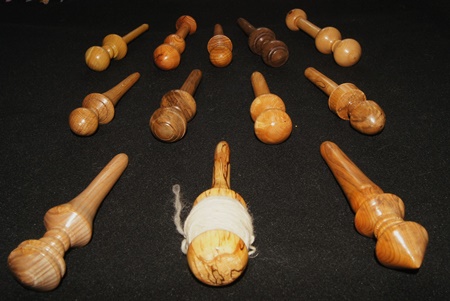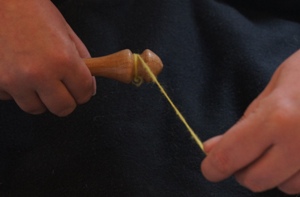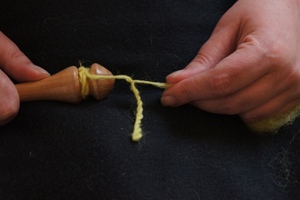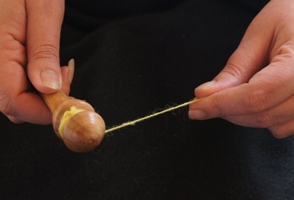


We were first introduced to stick spinning by a lovely lady called Monique who hailed from Normandy. She had been invited to the 2011 NPWI show by a friend to help with some weaving but also went round demonstrating a spinning technique to whoever she could corner for a couple of minutes. What was great about the technique was that people who had never got on with drop spindling picked it up rreally easily.
As nobody else was,I decided to make some tools for carryin out the technique. Monique used an old mill bobbin but I wanted to produce something ergonomically designed for stick spinning. Key points were a thin very smooth handle and a recession in the head to allow the cop to be built up. Other than that the shape of each individual could be dictated by the patterning and turning qualities of the wood blank it was made from.
The big issue was then what to call the tools. This was solved at the 2012 Woolfest when a chance meeting with a group from Derbyshire SWD Guild led to them suggesting 'Spurtzleur' as the tools resemble porridge spurtles and are twizzled. The 'eur' ending came in honour of Monique's french nationality.
All our spurtzleurs are hand turned from mainly UK-sourced wood (sometimes recycled) with any tropical hardwoods coming from suppliers with a strong ethical record. We also use locally harvested timber from trees that have blown down or had to be removed due to disease.
Spurtzleurs, for us are the easiest way to learn to spin. At various shows, we have had a number of people spin yarn for the first time within a few minutes of instruction. The under 10's seem particularly adept so it is a great way to introduce spinning to children. While learning in the flesh is the best way here is a basic beginners guide:

First take some fibre, roving is often easiest but batts or sliver also work well. Draft some of the fibre out then twist the end manually to start off the yarn.

Wrap the twisted fibre around the dip at the head end of the spurtzleur. This will start off the cop of spun yarn and keep the yarn at the head end. Then wrap more fibre 4-5 times around the spurtzleur to give the fibre a good grip before spinning.


Now to spin yarn. Hold the tail end of the spurtzleur loosely in one hand. The key is to support the stick but keep the grip sufficiently loose that the stick can rotate freely in the hand holding it. Then grip the drafted fibre tightly in the other hand about 3-4 inches from the spurtzleur.

To spin yarn rotate the hand holding the fibre in a circular motion, a bit like the movement of your foot when pedalling a bike. If the grip on the spurtzleur is loose enough this should lead to it rotating around allowing twist to be put in the drafted fibre.


If the grip is too tight the fibre will just wrap around the stick. If this happens unwind and start again holding the spurtzleur more loosely. As soon as you start to feel confident speed up as this will actually make the action easier. Also many people start rotating the hand holding the stick so that both hands are mimicking the action of pedals on a bike. Eventually a good amount of twist will develop and the fibre will start to twist back on itself. When this happens move the fingers holding the fibre back down the draft allowing the twist to move down the fibre.

Wind the spun yarn onto the stick by rotating the stick.

More fibre can then be drafted out and the spinning process repeated.

When a substantial cop has built up the yarn can be wound off and plied using the andean plying technique by rotatin the spurtzleur in the opposite direction.
